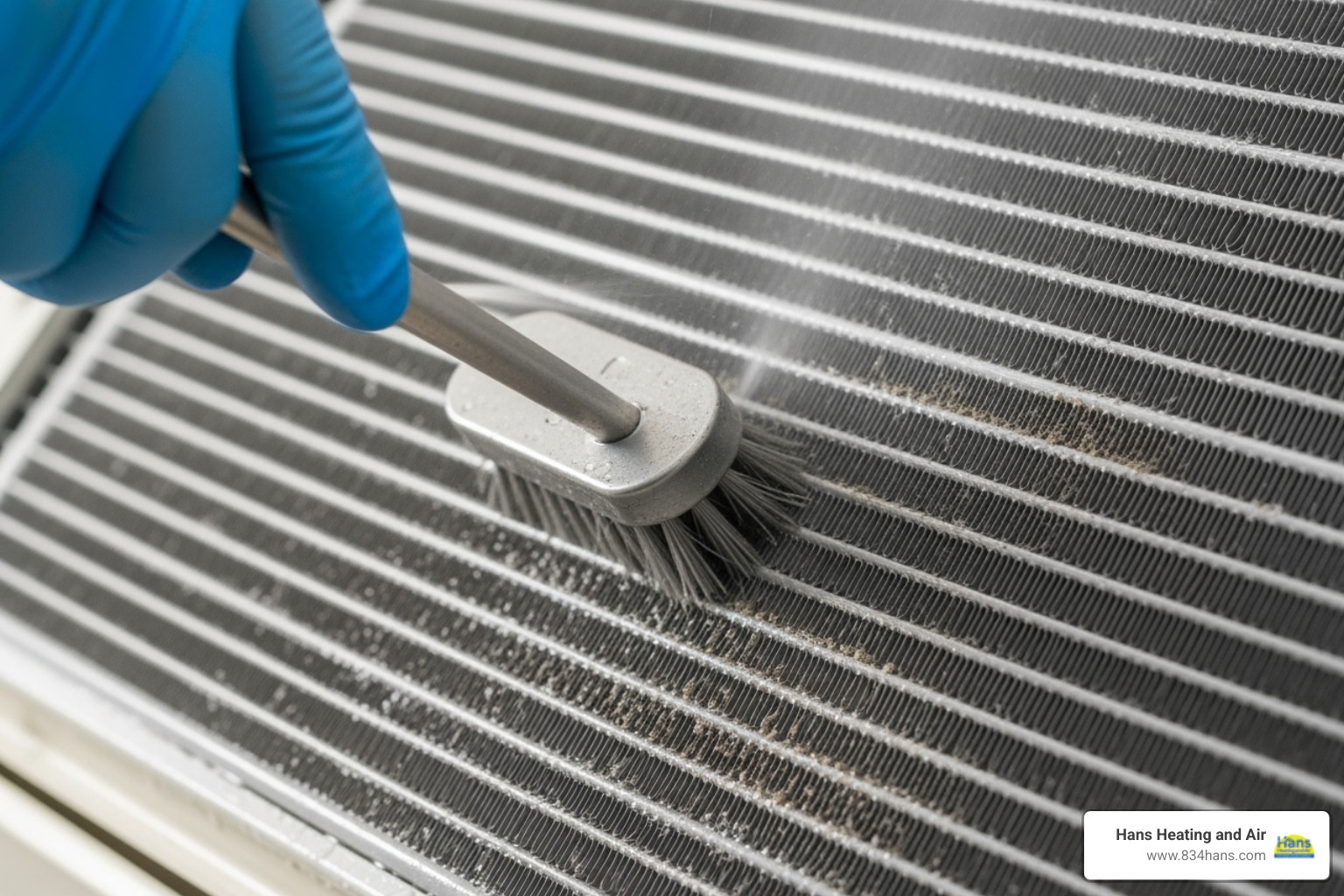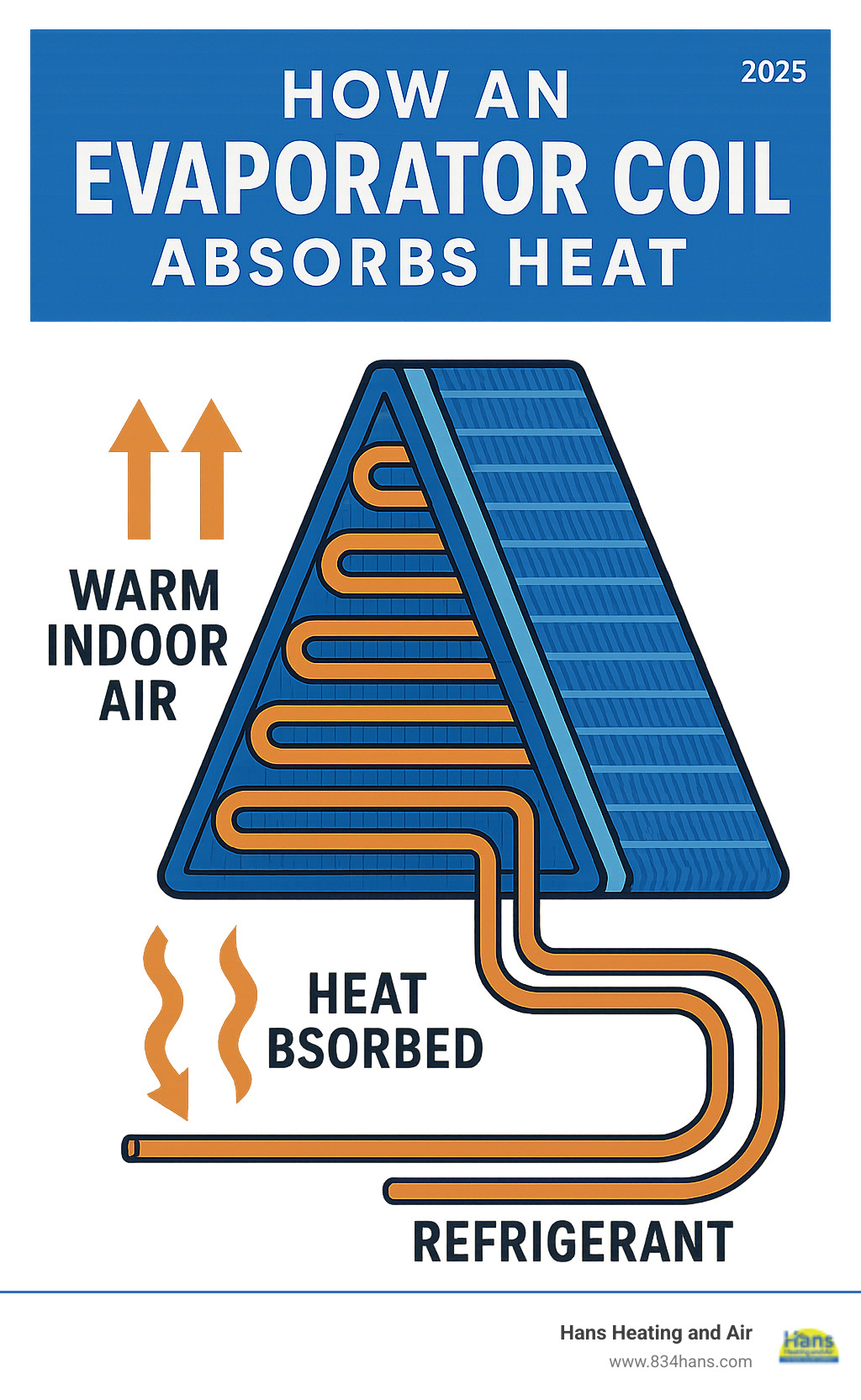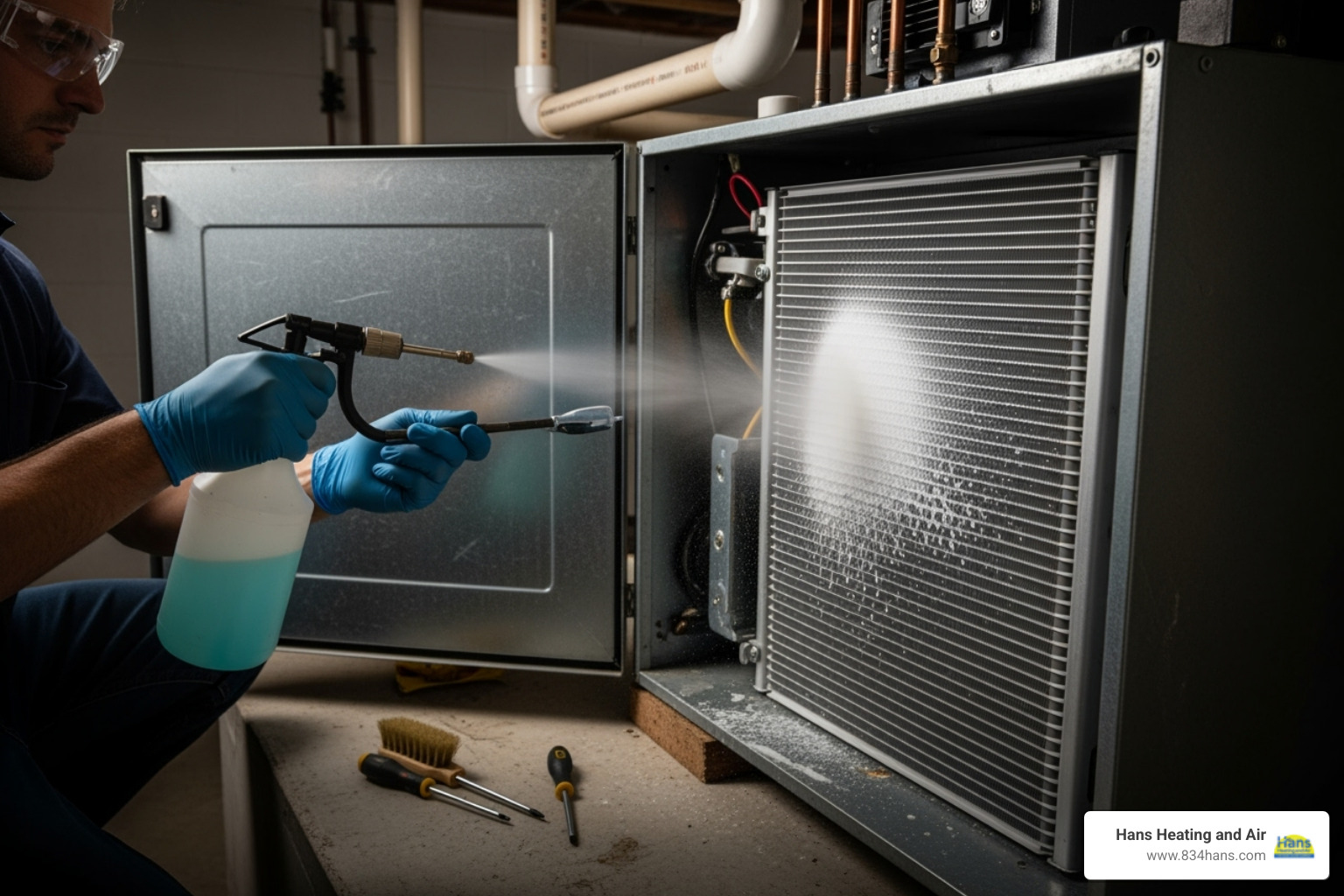Sparkling Coils, Happy Home: A DIY Guide to Evaporator Coil Cleaning
Why Evaporator Coil Cleaning Makes Your AC Work Better

Evaporator coil cleaning is one of the most important maintenance tasks you can do for your air conditioning system. When done right, it can improve your AC's efficiency by up to 30% and save you hundreds of dollars a year on energy bills.
Quick cleaning checklist:
- Turn off power at the breaker before starting
- Remove access panel to reach the evaporator coil
- Spray with no-rinse coil cleaner and let it work
- Gently brush away stubborn dirt with a soft brush
- Clean the drain pan to prevent mold growth
- Reassemble everything and restore power
Is your AC running constantly but not cooling well? Are your electric bills getting bizarrely high? The culprit might be a dirty evaporator coil packed with dust, dirt, and debris.
Your evaporator coil works by absorbing heat from your home's air. When it's covered in grime, it can't do its job properly. This forces your system to work harder and longer, driving up energy costs and shortening your AC's lifespan.
The good news? Most homeowners can clean their evaporator coils themselves with basic tools and a little patience. This simple maintenance task can restore your system's performance and help it run efficiently for years to come.

Why a Clean Evaporator Coil is Your AC's Best Friend
When your AC's evaporator coil is clean, it works efficiently to keep your home comfortable and energy bills reasonable. But a dirty coil creates a domino effect of problems.
- Reduced Cooling: Dust and grime act like an insulating blanket, preventing the coil from absorbing heat. Your AC runs longer trying to cool your home, but never quite succeeds.
- Increased Energy Bills: An inefficient coil forces your system to work overtime, increasing energy usage by up to 40% while cooling drops by 30%.
- System Strain: The extra workload puts serious strain on components like the compressor, leading to premature wear and expensive repairs.
- Mold and Bacteria: The combination of moisture and debris on a dirty coil is a perfect breeding ground for mold and bacteria. This can lead to musty odors circulating through your vents.
- AC Freezing Up: It sounds counterintuitive, but a dirty coil can't absorb enough heat, causing the refrigerant to get too cold. Moisture then freezes on the coil, forming an ice block that stops airflow.
- Water Leakage: When the ice melts, it can overwhelm the drain pan, leading to water damage around your indoor unit.
Regular evaporator coil cleaning prevents these issues and keeps your system running smoothly. For more detailed guidance on keeping your AC in peak condition, check out our comprehensive guide on AC maintenance for optimal performance.
The Role of the Evaporator Coil
Located inside your air handler unit (in your attic, closet, or basement), the evaporator coil is an A-shaped assembly of metal fins and copper tubing that does the actual cooling.
Your AC doesn't create cold air; it removes heat. The heat exchange process works like this: warm, humid air from your home is drawn across the coil. Cold liquid refrigerant inside the tubing absorbs the heat, turning from a liquid into a gas. This process also provides dehumidification, as moisture from the air condenses on the cold coil and drains away, removing that sticky feeling from the air.
The heat-laden refrigerant gas then travels to the outdoor condenser coil to release the absorbed heat. The evaporator coil is the indoor workhorse, focused on heat absorption and moisture removal.
When dust and debris coat the fins, this heat transfer process is disrupted. That's why evaporator coil cleaning is critical for efficiency. For industry best practices, the National Air Duct Cleaners Association provides excellent guidance.
Telltale Signs Your Coil Needs Cleaning
Your AC will give you distress signals when the evaporator coil is dirty. Recognizing them can save you from bigger problems. Here's what to look for:
- Weak airflow: If you barely feel a breeze from your vents, dirt is likely choking the coil.
- AC runs constantly: A dirty coil struggles to absorb heat, forcing your system to run endlessly without reaching the set temperature.
- Higher utility bills: Energy costs can spike dramatically when your system works harder to achieve the same cooling results.
- Frozen coils: Ice on your indoor unit is a clear sign that heat transfer has been severely compromised.
- Unpleasant smells: Musty or sock-like odors from your vents often indicate mold or bacteria growing on the dirty coil.
- Water leakage: Water pooling around your indoor unit can be caused by melted ice or an overwhelmed drain pan.
If you're experiencing these symptoms, it's time to check your evaporator coil. For a broader look at AC warning signs, our guide on signs your AC needs a tune-up covers additional symptoms to watch for.
Your Step-by-Step Guide to Evaporator Coil Cleaning

Ready to give your evaporator coil the attention it deserves? Don't worry – while cleaning your AC's evaporator coil might sound intimidating, it's actually a straightforward process that most homeowners can tackle with confidence. Think of it as giving your hardworking AC system a well-deserved spa day!
Safety comes first, always. Before we dive into the fun stuff, we're working with electrical equipment and cleaning chemicals. Taking proper precautions isn't just smart – it could save you from injury or costly mistakes.
The beauty of evaporator coil cleaning lies in its simplicity. With the right approach and a little patience, you'll have your coil looking and performing like new in just a few hours. Your AC (and your electric bill) will thank you for it!
Essential Tools and Materials for Evaporator Coil Cleaning
Before you start, let's gather everything you'll need. Having all your tools ready makes the job flow smoothly and prevents those frustrating trips to the hardware store mid-project.
Your safety gear is non-negotiable. Gloves and goggles protect you from cleaning chemicals and flying debris. Trust me, getting coil cleaner in your eyes is not an experience you want to have!
For accessing your unit, you'll need a screwdriver or nut driver set to remove those pesky access panels. Every air handler is a little different, so having a variety of sizes on hand saves time and frustration.
The star of the show is your no-rinse evaporator coil cleaner. These magical cleaners foam up, grab onto dirt and grime, then rinse away naturally with your AC's condensation. No messy rinsing required!
A soft bristle brush helps coax stubborn dirt away without damaging those delicate aluminum fins. Think gentle persuasion, not aggressive scrubbing.
Your vacuum cleaner with a brush attachment is perfect for the initial cleanup, whisking away loose dust and pet hair before the deep cleaning begins. A fin comb comes in handy if you find bent fins that need straightening.
Don't forget about the drain pan! A bucket, some mild detergent, and a spray bottle help you tackle any mold or algae that might have taken up residence down there.
The Cleaning Process: From Grime to Shine
Now for the main event! Follow these steps carefully, and you'll have your evaporator coil sparkling clean in no time.
Turn off the power – this isn't optional! Head to your electrical panel and flip the breaker that controls your AC unit. Also switch your thermostat to "off." I can't stress this enough – working on live electrical equipment is dangerous and unnecessary.
Finding your evaporator coil is like a treasure hunt, except the treasure is tucked away in your attic, utility closet, or basement. Once you locate your air handler unit, look for the access panel. You'll typically need to remove a few screws or unclip some fasteners. Some panels have foil tape sealing the edges – carefully peel this back and save it for reassembly.
Take a moment to inspect what you're working with. Is it just dusty, or are there clumps of pet hair and debris? Start with your vacuum and brush attachment to remove the loose stuff. Be gentle with those fins – they bend easily and work best when they're straight.
Here's where the magic happens! Apply your no-rinse coil cleaner according to the label directions. Watch as it foams up and starts breaking down months of accumulated grime. The foam will do most of the work for you – just let it sit for the recommended time, usually 10-15 minutes.
For stubborn spots, your soft brush becomes your best friend. Gentle brushing can coax away embedded dirt, but remember – those fins are delicate. Think of it like brushing a cat – firm enough to be effective, gentle enough to avoid damage.
While the cleaner works its magic upstairs, check that drain pan underneath. This is where all the condensation and dirty cleaning solution ends up. If you spot standing water, slime, or that telltale musty smell, it's time for a thorough cleaning. Remove any debris by hand (gloves on!), then use your mild detergent solution to scrub away mold and algae.
Reassembly is straightforward – just reverse what you did to get in there. Replace the access panel, secure those screws, and reapply any foil tape you removed. Head back to your electrical panel, flip that breaker back on, and set your thermostat to cool.
Fire up your system and listen. You should notice improved airflow almost immediately. That's the sound of a job well done – and an AC system that can finally breathe freely again!
DIY vs. Professional Cleaning: Making the Right Call
We've just walked through a complete DIY evaporator coil cleaning process, and honestly, it's pretty satisfying to tackle this yourself! Many homeowners find it rewarding to roll up their sleeves and give their AC the care it deserves. But here's the thing – sometimes calling in the pros isn't just the easier choice, it's the smarter one.
Think of it like cooking. You can make a great pasta dinner at home, but when you want that perfect wedding cake, you probably call a baker, right? The same logic applies to your AC maintenance.
Cost is usually the biggest factor for most folks. DIY cleaning costs you maybe $20-30 for cleaner and basic tools, while professional service involves labor and expertise fees. However, time tells a different story. What might take you a full Saturday afternoon (plus a trip to the hardware store when you realize you need that fin comb), a professional can knock out efficiently as part of a comprehensive maintenance visit.
Thoroughness is where professionals really shine. While your DIY efforts can handle surface dirt and accessible areas beautifully, HVAC technicians have specialized equipment that can reach every nook and cranny. They can spot underlying issues you might miss – like early signs of coil corrosion or refrigerant leaks that could turn into expensive problems later.
The risk factor is worth considering too. Yes, there's potential for coil damage, electrical mishaps, or simply missing important warning signs when you go it alone. Professionals minimize these risks with their training and experience, plus they carry insurance for those "oops" moments.
When it comes to equipment, your household tools and store-bought cleaners work great for routine maintenance. But professionals bring industrial-grade vacuums, specialized diagnostic tools, and commercial cleaners that can tackle tougher jobs more effectively.
When to Call a Professional for Evaporator Coil Cleaning
Sometimes your AC sends pretty clear signals that it needs more than a weekend warrior can provide. At Hans Heating and Air, we've seen it all, and we want you to know when it's time to let our experts step in.
Heavy mold growth is definitely a red flag for professional intervention. If you're looking at more than just surface dust – we're talking about thick, black, or green growth that's worked its way deep into the coil structure – that's beyond DIY territory. Our technicians have specialized biocides and equipment to safely eliminate mold without spreading harmful spores throughout your home.
Inaccessible coils can turn a simple cleaning into a frustrating puzzle. Some air handlers are tucked into impossibly tight spaces or require significant disassembly to reach the coil properly. Rather than risk damaging other components trying to squeeze into that cramped attic space, our team can safely access and even remove coils for deeper cleaning when necessary.
Here's a big one: if you suspect a refrigerant leak, stop everything and call us immediately. Signs include hissing sounds, reduced cooling despite a clean coil, or ice formation on the lines even after cleaning. Refrigerant handling is federally regulated and requires special training and equipment – it's not a DIY job, period.
Bent fins happen, and while minor ones respond well to a fin comb, extensive damage is another story. If your coil looks like it went ten rounds with a vacuum cleaner, or if you see corrosion and significant damage, professional assessment is crucial for determining repair versus replacement needs.
Clogged drain lines can be tricky. You might clear a simple blockage, but persistent clogs or frequent overflows often indicate deeper issues like algae growth throughout the drain system. Our team can thoroughly clear and treat the entire drainage network.
Sometimes a dirty coil is just the tip of the iceberg, signaling underlying system issues like improper airflow, failing compressors, or low refrigerant levels. During comprehensive maintenance visits, our technicians follow industry standards like those outlined in ACR, The NADCA Standard to diagnose these bigger picture problems.
Knowing when to call for help isn't admitting defeat – it's being smart about protecting your investment and your family's comfort. For more insights on why professional maintenance matters, check out our article on Why Air Conditioning Maintenance is Important.
Preventative Tips to Keep Coils Cleaner, Longer
The best evaporator coil cleaning is the one you don't have to do as often! While periodic cleaning will always be necessary, a few smart habits can dramatically reduce dirt buildup and keep your coils looking good longer.
Regular filter changes are absolutely the most impactful thing you can do. Think of your air filter as a bouncer at an exclusive club – it decides what gets through to your expensive coil. When that bouncer gets overwhelmed (aka clogged), dust, pet hair, and all sorts of unwanted particles crash the party on your evaporator coil. Check your filter monthly and swap it out every one to three months, or more frequently if you have furry family members or live somewhere particularly dusty.
Even if you're becoming a DIY cleaning expert, annual professional tune-ups are still invaluable. During these visits, our Hans Heating and Air technicians perform comprehensive inspections, clean hard-to-reach components, lubricate moving parts, check refrigerant levels, and catch potential problems before they become wallet-draining emergencies. It's like an annual physical for your AC system. Learn more about what's included in our Air Conditioning Tune-Up service.
Keep the area around your indoor unit clear – it needs room to breathe! Avoid using that space as extra storage, even though it might seem convenient. Good airflow around the unit prevents debris from getting sucked into the system and helps everything operate more efficiently.
For homes that seem to generate dust faster than you can clean it, air purifiers can be game-changers. High-quality units significantly reduce airborne particles, which means fewer contaminants reaching your coils in the first place. It's an investment that pays dividends in cleaner coils and better indoor air quality.
These simple preventative measures don't just keep your evaporator coils cleaner – they contribute to your entire HVAC system's health, efficiency, and longevity. A little prevention today saves a lot of headaches tomorrow!
Frequently Asked Questions about Evaporator Coil Cleaning
We love chatting with homeowners about evaporator coil cleaning – it's one of those topics that seems mysterious at first but becomes much clearer once you understand the basics. Over the years, we've noticed the same questions pop up again and again, so let's tackle the most common ones together!
How often should I clean my evaporator coils?
This is probably the question we hear most often, and honestly, it's a smart one to ask! The simple answer is that most homes benefit from annual inspection of their evaporator coils, with a thorough cleaning every 1-3 years. But here's where it gets interesting – your home might be completely different from your neighbor's.
Think of it like this: if you have three golden retrievers who love rolling in the yard, your coils are going to get dirty much faster than someone with no pets and a pristine home. Pets are one of the biggest factors affecting how often you'll need cleaning. All that pet dander and fur has to go somewhere, and unfortunately, some of it ends up on your coils.
Dusty environments also speed things up. If you live near a construction site, have a gravel driveway, or your area just tends to be dusty, you might find yourself cleaning every year or two instead of every three.
Here's a pro tip: your air filter habits make a huge difference. If you're religious about changing your filter every 1-3 months (and we really hope you are!), your coils will stay cleaner much longer. Skip those filter changes, though, and you're basically inviting all that dirt to set up camp on your evaporator coil.
The best way to know for sure? Take a peek during your regular filter changes. If you can see visible dirt buildup on the coil, it's time for a cleaning session.
What kind of cleaner is safe for evaporator coils?
We're so glad you asked about safety first – that's exactly the right approach! Not all cleaners are created equal, and using the wrong one can actually damage your system.
Commercial no-rinse cleaners are your best friend for DIY evaporator coil cleaning. These clever products foam up, grab onto all that dirt and grime, then condense with the moisture from your coil and drip right into the drain pan. No mess, no fuss, and no need to rinse afterward. Just make sure you follow the instructions on the bottle – they know what they're talking about!
If you're in a pinch or prefer a more natural approach, a mild detergent mixed with water can work for light cleaning jobs. We're talking just a tiny squirt of gentle dish soap in warm water. Spray it on, let it work, and either wipe gently or let it drip away naturally.
Now, here's what you absolutely want to avoid: harsh chemicals, strong acids, or anything abrasive. Your evaporator coil has delicate metal fins and protective coatings that can be damaged by aggressive cleaners. Once that protective coating is gone, you're looking at corrosion and reduced efficiency – definitely not what we want!
Always read those product labels carefully. They'll tell you about proper dilution, safety gear you should wear (like gloves and goggles), and any special precautions.
Can a dirty evaporator coil make me sick?
This is such an important question, and unfortunately, the answer is yes – a dirty evaporator coil can definitely impact your health and your family's wellbeing.
Here's what happens: that cool, moist environment around your evaporator coil is like a five-star resort for mold, mildew, and bacteria. They absolutely love growing on all that accumulated dust and debris. The problem is, when your AC kicks on, it doesn't just circulate cool air – it also sends those mold spores and bacteria floating throughout your entire home.
For people with allergies or asthma, this can be particularly troublesome. You might notice more sneezing, coughing, watery eyes, or that scratchy throat feeling. Some folks even experience skin irritation. If you've been wondering why your respiratory symptoms seem worse when the AC is running, a dirty coil might be the culprit.
Even if you don't have specific allergies, poor indoor air quality from a contaminated coil can make your home feel stuffy and uncomfortable. Those musty odors wafting from your vents? That's often mold and bacteria saying hello from your dirty coil.
The good news is that regular evaporator coil cleaning can help prevent these issues and keep your indoor air fresh and healthy. If you're noticing persistent strange smells or unexplained respiratory issues when your AC runs, it's definitely worth investigating your coil's condition.
Your family's health and comfort are too important to ignore – a clean coil is an investment in both your system's efficiency and your wellbeing.
Conclusion
We hope this guide has opened your eyes to just how much your AC's evaporator coil cleaning can transform your home's comfort! What started as a simple maintenance task has revealed itself to be one of the most powerful ways to boost your system's performance, save money, and keep your family breathing easier.

Think about it – with just a few hours of work and some basic tools, you can potentially improve your AC's efficiency by up to 30%. That's like getting a brand-new system without the hefty price tag! Your energy bills will thank you, especially during those sweltering Alabama summers when your AC is working overtime.
But the benefits go far beyond your wallet. Better air quality means your family breathes cleaner, fresher air every single day. No more mysterious musty odors or worrying about mold and bacteria circulating through your home. And by reducing the strain on your system, you're helping it live a longer, happier life – potentially adding years to its lifespan and avoiding those unexpected repair calls that always seem to happen at the worst possible times.
We know that tackling DIY maintenance can feel intimidating at first, but you've got this! The step-by-step process we've outlined is designed to be manageable for most homeowners. You're not just maintaining equipment – you're taking control of your home's comfort and your family's well-being.
Of course, there are times when calling in the professionals makes perfect sense. Whether you're dealing with heavy mold growth, hard-to-reach coils, or you simply want the peace of mind that comes with expert service, we at Hans Heating and Air are here for you. Our team proudly serves Montgomery, Hope Hull, Lake Martin, Millbrook, Pike Road, Prattville, Wetumpka, and all across Central Alabama with the high-quality, efficient, and timely solutions you deserve.
Your AC works hard to keep you comfortable year-round. Give it the care it deserves with regular evaporator coil cleaning, and it'll reward you with reliable performance, lower bills, and that perfectly cool, clean air your family loves coming home to.
Ready to learn more about keeping your entire HVAC system in peak condition? Learn more about our professional heat pump services in Montgomery, AL and find how we can help your system run smoothly for years to come.
Other Services
Community Involvement
























